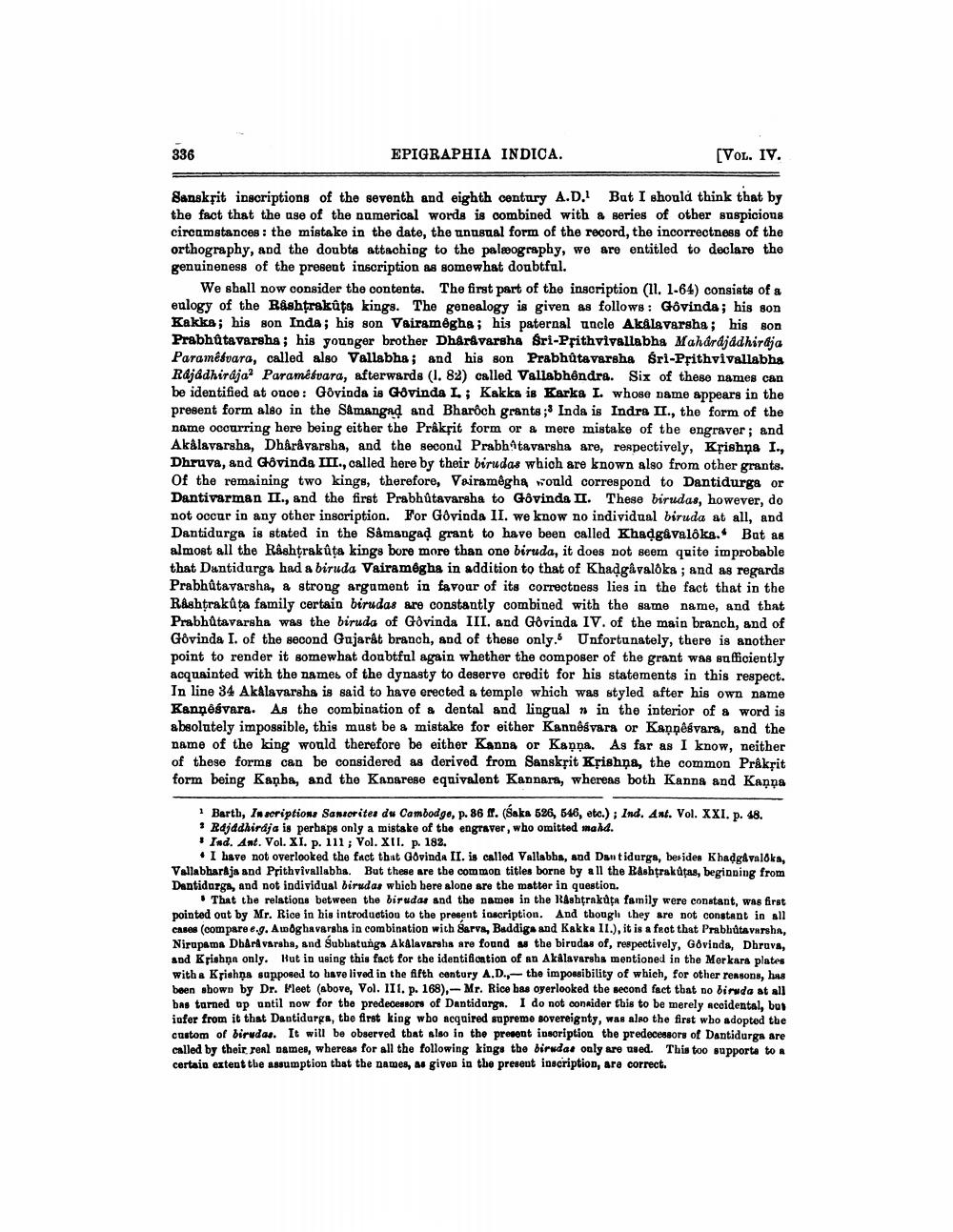________________
336
EPIGRAPHIA INDICA.
[VOL. IV.
Sanskrit inscriptions of the seventh and eighth century A.D. Bat I should think that by the fact that the use of the numerical words is combined with a series of other suspicious circomstances: the mistake in the date, the unusual form of the record, the incorrectness of the orthography, and the doubts attaching to the palæography, we are entitled to declare the genuineness of the present inscription as somewhat doubtful.
We shall now consider the contents. The first part of the inscription (11. 1-64) consists of a eulogy of the Rashtrakūta kings. The genealogy is given as follows: Govinda; his son Kakka; his son Inda; his son Vairaméghe; his paternal uncle Akalavaraha; his son Prabhatavarsha; his younger brother Dhårdvarsha Sri-Prithvivallabha Maharajadhirdja Paramêsvara, called also Vallabha; and his son Prabhůtavarsha Sri-Prithvivallabha Rajadhiraja' Paramédvara, afterwards (1. 82) called Vallabhêndra. Six of these names can be identified at once: Govinda is Govinda L ; Kakka is Karka I. whose name appears in the present form also in the Samangad and Bharôch grants ;' Inda is Indra II., the form of the name occurring here being either the Präkfit form or a mere mistake of the engraver; and Akalavarsha, Dhårdvarsha, and the second Prabhatavarsha are, respectively, Krishna I., Dhruva, and Govinda III., called here by their birudas which are known also from other grants. Of the remaining two kings, therefore, Vairamégha vould correspond to Dantidurga or Dantivarman II., and the first Prabhůtavarsha to Gôvinda II. These birudas, however, do not occur in any other inscription. For Govinda II. we know no individual biruda at all, and Dantidurga is stated in the Såmangad grant to have been called Khadgávalóka.. Bat as almost all the Rashtrakūta kings bore more than one biruda, it does not seem quite improbable that Dantidurga had a biruda Vairam@gha in addition to that of Khadgåvalka ; and as regards Prabhůtavarsha, a strong argument in favour of its correctness lies in the fact that in the Rashtrakūta family certain birudas are constantly combined with the same name, and that Prabhůtavarsha was the biruda of Govinda III. and Govinda IV. of the main branch, and of Govinda I. of the second Gujarat branch, and of these only. Unfortunately, there is another point to render it somewhat doubtful again whether the composer of the grant was sufficiently acquainted with the names of the dynasty to deserve credit for his statements in this respect. In line 34 Akalavarsha is said to have erected a temple which was styled after his own name Kannesvara. As the combination of a dental and lingual in the interior of a word is absolutely impossible, this must be a mistake for either Kannê vara or Kannesvara, and the name of the king would therefore be either Kanna or Kapna. As far as I know, neither of these forms can be considered as derived from Sanskrit Krishna, the common Pråksit form being Kanba, and the Kadarese equivalent Kannara, whereas both Kanna and Kanna
Barth, Inscriptions Santorites du Cambodge, p. 86 ff. (Šaka 526, 546, etc.); Ind. Ant. Vol. XXI. p. 48. ? Rajadhiraja is perhaps only a mistake of the engraver, who omitted mahd. • Ind. Ant. Vol. XI. p. 111; Vol. XII. p. 182.
. I have not overlooked the fact that Govinda II. is called Vallabhs, and Dan tidurga, besides KhadgAvalok, Vallabharaja and Prithvivallabha. But these are the common titles borne by all the Rashtrakūtas, beginning from Dantidarga, and not individual birudas whicb bere alone are the matter in question.
That the relations between the birudas and the names in the Rashtrakūta family were constant, was first pointed out by Mr. Rice in his introduction to the present inscription. And though they are not constant in all CASAS (compare e.g. Aun Oghavarsha in combination with Sarve, Baddiga and Kakka 11.), it is a feat that Prabhůta varsha, Nirupama DbArAvarsha, and Subbatunga Akalavarsha are found as the birodas of, respectively, Govinda, Dhruva, and Krishnn only. But in using this fact for the identification of an Akalavarshs mentioned in the Merkara plates with a Krishna supposed to have lived in the fifth century A.D.,- the impossibility of which, for other reasons, has been shown by Dr. Vleet (above, Vol. II1. p. 168),- Mr. Rice bas oyerlooked the second fact that no birida at all bas turned up until now for the predecessors of Dantidorge. I do not consider this to be merely accidental, but iofer from it that Dantidurga, the first king who acquired supreme sovereignty, was also the first who adopted the custom of birudas. It will be observed that also in the present inscription the predecessors of Dantidurga are called by their real names, whereas for all the following kings the birudat only are used. This too supporta to certain extent the assumption that the names, as given in the present inscription, ara correct.




